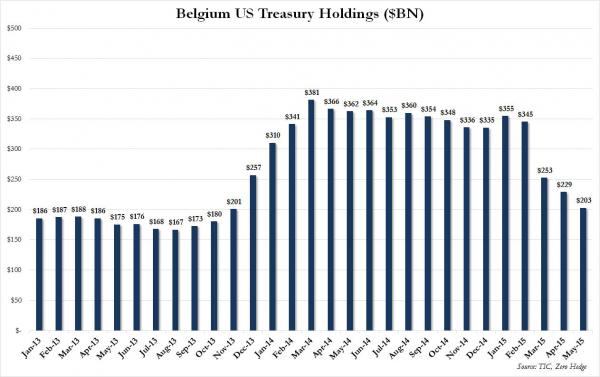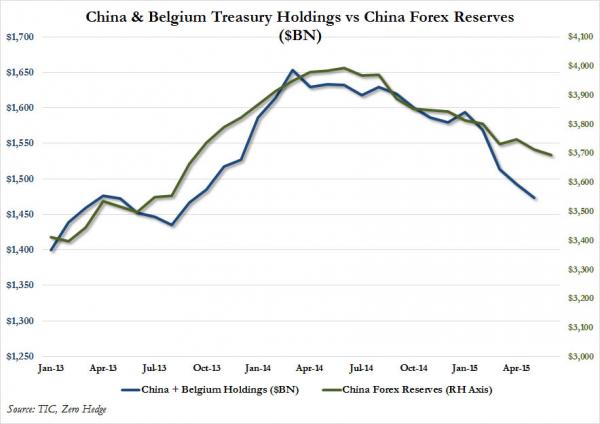Mystery Buyer Of US Treasurys Revealed

Back in March 2014, we first revealed something quite stunning: a new, seemingly ravenous, and completely unexpected buyer of US Treasurys had emerged in the face of “Belgium” which was buying tens of billions in US paper at a weekly clip, without any explanation.
One year later, this website first confirmed that the identity of the “Belgian” buyer was none other than China, which had been using Belgian-based clearer Euroclear as an offshore venue for its bond purchases, and which starting in March 2015 had commenced dumping the US paper it accumulated so dramatically in 2013 and 2014, in advance of what has become the biggest story of the summer: China’s liquidation of its FX reserves, read US Treasury holdings, in defense of its devaluing currency.


And while we knew that China was selling – and following the record selling of FX reserves in August, so does everyone else – an even more interesting question emerged: who is buying?
Thanks to the WSJ we now have the answer: “A little-known New York hedge fund run by a former Yale University math whiz has been buying tens of billions of dollars of U.S. Treasury debt at recent auctions, drawing attention from the Treasury Department and Wall Street.”
The hedge fund in question, Jeffrey Talpins’ Element Capital Management, which according to the WSJ has become “the largest purchaser in dozens of government-bond auctions over the past 10 months, people familiar with the matter said. The buying is part of an apparent effort by the fund to use borrowed money to exploit small inefficiencies in the world’s most liquid securities market, a strategy that is delivering sizable profits, said people close to the matter.”

Jeffrey Talpins of Element Capital and his wife
For those unfamiliar, and Talpins certainly is not a household hedge fund name, “Mr. Talpins is an intense and reserved trader formerly at Citigroup Inc. and Goldman Sachs Group Inc. He is known for a tenacious style that can grate on rivals and once tested the patience of former Federal Reserve Chairman Ben Bernanke.”
According to the NYT, in 2005, Trader Monthly named Mr. Talpins one of the top 30 traders under 30, when he was still an employee of Vega Asset management. “Youth is not wasted on this crop, any of whom could be a billionaire by 40,” the magazine said. “Or, then again, they could be belly up and bust.”
Back in 2010 the FT profiled Element Capital, then at just $ 1.5 billion, saying that fixed-income relative value trading, “the hedge fund strategy pioneered – and made notorious – by Long Term Capital Management is returning to prominence amid one of its most successful years yet.” It added that “fixed-income relative value trading – shunned by investors after the collapse of LTCM in 1998 – has been one of the industry’s few outperformers this year, thanks to massive pricing anomalies caused by fiscal stimulus packages and unconventional central bank monetary policies around the world.”
As of the end of June, Element Capital, a $ 1.5bn relative value fund run by Jeffrey Talpins, was up 10.75 per cent. High returns have been driven by government bond markets flush with arbitrage opportunities, managers said.
By 2014, Element had grown substantially, and according to a Bloomberg note, last July it attracted the head of North America sales at RBS, Richard Tang: “Tang, who has spent almost two decades at the bank, is one of 16 members of the Treasury Borrowing Advisory Committee that the U.S. government consults with on its debt sales. His departure was confirmed by Sarah Lukashok, a Stamford, Connecticut-based spokeswoman for Britain’s largest state-owned lender. He will be joining New York-based Element Capital, which manages about $ 4.3 billion in its macro fund, said the people, who asked not to be named because the move wasn’t public.”
In other words, Element is not only growing its AUM exponentially, it now also employs a member of the TBAC, which we profiled in November 2011 as “The Supercommittee That Really Runs America.”
Not only that, but according to a November 2014 presentation to the Wharton Investment and Trading Group, the fund, then already at a $ 5 billion AUM, boasting it “has delivered exceptional returns to investors over its 9+ year track record, with annualized performance greater than 20% and a Sharpe ratio greater than 2.”
Quite an impressive performance for a smallish relative-value hedge fund, one that begs the question: just how much leverage is involved (an important question for later).
So why is this relatively obscrue hedge fund in the news? Well, it appears that the mystery buyer of all China’s bond sales is none other than Element:
Element has been the largest bidder in many of the 62 Treasury note and bond auctions between last November and July, these people said. At many recent auctions, some of which involved sales of more than $ 30 billion of debt, Element purchased about 10% of the issue, these people said. That is an unusually large figure, analysts said.
And while Element may have grown substantially, some wonder how its most recent AUM of $ 6 billion can sustain this ravenous buying spreed.
Element’s activity has raised questions because the cumulative purchases far exceed the hedge fund’s $ 6 billion in assets under management. Treasury officials, who frequently meet with large auction participants, have asked Element about its activity, said someone close to the matter.
“Their buying is eyebrow-raising,” said a trader who once worked for a firm that deals in government securities and witnessed Element’s bidding. These primary dealers often know the identity of other auction bidders. Element “never shared its strategy, but we often asked,” the trader said.
And this is where it gets tricky, because as the WSJ admits, the US Treasury “likes to know who is buying its bonds and why, partly because it prefers long-term holders such as pension funds, insurance companies and central banks. Treasury officials fear purchases by trading-oriented funds could result in sales that increase market swings and potentially drive up borrowing costs.
“If you’re issuing debt, your preference is those ‘sticky investors,’” said Scott Skyrm, a managing director at Wedbush Securities.
Which brings us back to the “how much leverage is involved” question, because one bad day for Element and suddenly the fund could be forced to unwind its giant Treasury book into what is already a very illiquid market.
Which leads to the question of just what is Element’s strategy: “Element had been shorting, or betting against, bonds in anticipation of higher interest rates but has been exiting from that wager, according to someone close to the matter. That is one reason the fund has been a big buyer of Treasurys lately.”
It appears that is not only macro considerations that drive Elements trading strategy, but also market mispricings between the primary and secondary market: “people who have worked with the firm or are close to Mr. Talpins said there is another reason: Element is among the last to embrace “bond-auction strategies,” trading maneuvers that have become less popular since the financial crisis.”
These trades aim to take advantage of the effects of supply and demand in the $ 12.8 trillion Treasury market. Demand for these bonds often fluctuates based on factors including investor perceptions of economic growth and market risk, while supply can be affected by regular auctions of different-maturity Treasury securities. A burst of new supply tends to slightly depress prices for short periods, sometimes for less than an hour.
Elements’s auction arbing strategy is relatively simple: “In the past, Wall Street dealers and hedge funds scored profits shorting “when-issued” bonds. These are contracts conferring the right to purchase Treasury securities when they are sold days later at auction. Then, these traders would buy bonds during Treasury auctions at the slightly lower prices and use these newly purchased bonds to close out their short sales.”
The difference between the higher price at which they sold the Treasurys and the lower price they paid at auction was their profit.
Which incidentally explains our “discovery” earlier this summer why Treasury auctions that took place at a time when the OTR was trading “special” led to dramatic outperformance during the actual auction: it was hedge funds like Element that did all in their power to squeeze the market and send the high yield deep inside the When Issued.
The reason why Element has become the dominant player in this market is because most of its competitors disappeared after 2008:
After the 2008 financial crisis, bank traders pulled back as regulators discouraged trading risks. Some hedge funds also began shying away from bond-auction strategies. Wall Street banks have significantly cut back their lending to hedge funds.
The pullback by rivals has left Element with a large presence in bond auctions to complement strategies such as in foreign-currency derivatives, people close to the matter said. In 2008, the firm gained 35%, these people say, even as financial markets crumbled. The next year, Element was up 79%. Last year it rose just 2.9%.
And with nobody left to compete, and the Treasury market as illiquid as it is, it meant huge potential profits for Element: sure enough, the hedge fund “was up 18.5% through July of this year, an investor said, beating most hedge funds and overall markets. Some recent gains came from bullish wagers on the U.S. dollar, according to the person.”
So can anything go wrong with this strategy? Yes, plenty.
Once in a while, the prices of bonds being auctioned jump, rather than fall, for reasons such as bad economic news that prompts an investor flight to safety. Hedges sometimes don’t work out. And the strategy relies on inexpensive borrowing because each trade usually yields minimal profits.
In the 1990s, hedge fund Long Term Capital Management used leverage to profit from small discrepancies in the Treasury market before a market reversal swamped the firm. LTCM used much more leverage than Element does.
Only problem is nobody knows just how much more leverage, and whether Elements leverage isn’t slowly but surely creeping up to Merton and Merrywether levels.
Still, luminaries such as Yale professor Robert Schiller vouch for Talpins:
Mr. Talpins graduated in 1997 from Yale, where he was a research assistant for Robert Shiller, the Yale economist who later won a Nobel prize in economics. In a 1996 letter, Mr. Shiller wrote that in terms of overall performance, he “put Jeffrey first out of the 52 Yale undergraduates” who attended his course Economics 252, Finance, Theory and Application.
“I thought he was particularly bright,” recalls Prof. Shiller.
Others, however, were less than enthused about Talpins. Such as former Fed chairman Ben Bernanke:
A year or so ago, Mr. Talpins was among 20 investors invited by a Wall Street firm to a private meeting with Mr. Bernanke, after his departure from the Fed. Mr. Talpins peppered Mr. Bernanke with about 10 successive questions, according to several people in the room.
Mr. Talpins elicited some detailed answers, such as who is in the room during interest-rate discussions. But he also asked questions that exasperated some investors because they seemed irrelevant. Mr. Bernanke looked increasingly weary under Mr. Talpins’s barrage, one participant said. “Jeff was persistent and it got a little uncomfortable,” said another participant. “It was like, ‘Dude, let it go.’”
But the biggest risk by far is that now that the “mystery buyers” has been exposed, it won’t take long for the other, much bigger players – i.e., all the central banks who have been desperate to push yields lower to “confirm” the self-fulfilling narrative that the economy, and inflation, are growing – to inflict the proverbial “max pain” upon Element. In fact, if Talpins is indeed very long TSYs, and has lot of leverage embedded in the trade, one may expect a concerted shorting effort to find out just how much leverage is incorporate in the trades, and push it to the point of breaking. After all, hedge funds exposed with massive positions rarely survive an onslaught by their peers who seek to do just that – inflict “max pain” (see Ackman and Herbalife).
If so, China’s selling of TSYs may very soon inflict precisely the kind of damage on US paper not because it is selling, but because the biggest “mystery” buyer of US paper has just been revealed and whose continued ability to keep buying unimpeded is now suddenly very much in question.
What’s worse, if the result of a coordinated attack on Talpins leads to an LTCM-type blow up, hang on to your hats because the recent volatility in the equity market will be nothing compared to what is coming to the MOVE, TYVIX and US Treasurys…

